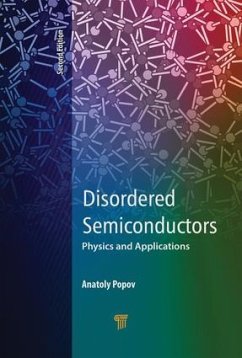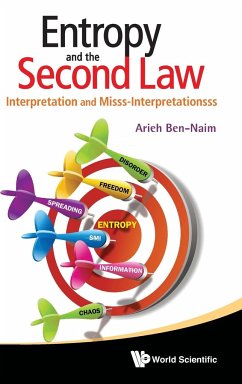Disordered Semiconductors Second Edition
Physics and Applications
Herausgeber: Popov, Anatoly
Disordered Semiconductors Second Edition
Physics and Applications
Herausgeber: Popov, Anatoly
- Gebundenes Buch
- Merkliste
- Auf die Merkliste
- Bewerten Bewerten
- Teilen
- Produkt teilen
- Produkterinnerung
- Produkterinnerung
Devices based on disordered semiconductors have wide applications. This textbook connects characteristic features of the atomic and electronic structures of disordered semiconductors and the device design process on the basis of these materials.
Andere Kunden interessierten sich auch für
![Computation in Science (Second Edition) Computation in Science (Second Edition)]() Konrad HinsenComputation in Science (Second Edition)47,99 €
Konrad HinsenComputation in Science (Second Edition)47,99 €![Physics for Technology, Second Edition Physics for Technology, Second Edition]() Daniel H NicholsPhysics for Technology, Second Edition186,99 €
Daniel H NicholsPhysics for Technology, Second Edition186,99 €![The Mathematics and Physics of Disordered Media The Mathematics and Physics of Disordered Media]() The Mathematics and Physics of Disordered Media35,99 €
The Mathematics and Physics of Disordered Media35,99 €![Introduction to Physics with Calculus, Second Edition Introduction to Physics with Calculus, Second Edition]() Douglas BarlowIntroduction to Physics with Calculus, Second Edition171,99 €
Douglas BarlowIntroduction to Physics with Calculus, Second Edition171,99 €![Introduction to the Mathematical Physics of Nonlinear Waves Introduction to the Mathematical Physics of Nonlinear Waves]() Minoru FujimotoIntroduction to the Mathematical Physics of Nonlinear Waves113,99 €
Minoru FujimotoIntroduction to the Mathematical Physics of Nonlinear Waves113,99 €![ENTROPY AND THE SECOND LAW ENTROPY AND THE SECOND LAW]() Ben-Naim AriehENTROPY AND THE SECOND LAW63,99 €
Ben-Naim AriehENTROPY AND THE SECOND LAW63,99 €![Handbook of Mathematical Methods and Problem-Solving Tools for Introductory Physics Handbook of Mathematical Methods and Problem-Solving Tools for Introductory Physics]() Heather M WhitneyHandbook of Mathematical Methods and Problem-Solving Tools for Introductory Physics112,99 €
Heather M WhitneyHandbook of Mathematical Methods and Problem-Solving Tools for Introductory Physics112,99 €-
-
-
Devices based on disordered semiconductors have wide applications. This textbook connects characteristic features of the atomic and electronic structures of disordered semiconductors and the device design process on the basis of these materials.
Produktdetails
- Produktdetails
- Verlag: Jenny Stanford Publishing
- 2. Auflage
- Seitenzahl: 342
- Erscheinungstermin: 1. August 2018
- Englisch
- Abmessung: 235mm x 157mm x 23mm
- Gewicht: 647g
- ISBN-13: 9789814774376
- ISBN-10: 9814774375
- Artikelnr.: 54062743
- Herstellerkennzeichnung
- Libri GmbH
- Europaallee 1
- 36244 Bad Hersfeld
- gpsr@libri.de
- Verlag: Jenny Stanford Publishing
- 2. Auflage
- Seitenzahl: 342
- Erscheinungstermin: 1. August 2018
- Englisch
- Abmessung: 235mm x 157mm x 23mm
- Gewicht: 647g
- ISBN-13: 9789814774376
- ISBN-10: 9814774375
- Artikelnr.: 54062743
- Herstellerkennzeichnung
- Libri GmbH
- Europaallee 1
- 36244 Bad Hersfeld
- gpsr@libri.de
Anatoly Popov
Preface 1. Introduction 1.1 Definition of Disordered State 1.2
Classification of Non-crystalline Systems 1.3 Qualitative and Quantitative
Characteristics of Glass Formation 2. Atomic Structure of Disordered
Semiconductors 2.1 Structural Characteristics of Solids 2.2 Short-Range and
Medium-Range Order 2.3 Methods of Investigation of Disordered System
Structure 2.4 Simulation of Disordered Material Structure 2.5 Results of
Structural Research of Disordered Semiconductors 3. Electronic Structure
and Properties of Disordered Semiconductors 3.1 Electronic Structure 3.2
Electrical Properties of Disordered Semiconductors 3.3 Optical Properties
of Disordered Semiconductors 3.4 Photoelectrical Properties of Disordered
Semiconductors 4. Methods for Controlling Properties of Disordered
Semiconductors 4.1 Doping of Hydrogenated Amorphous Silicon 4.2 Chemical
Modification of Chalcogenide Glassy Semiconductor Film Properties 4.3
Conductivity Type Inversion in Bulk Glassy Chalcogenide 4.4 Structural
Modification of Disordered Semiconductors Properties 4.5 Chemical
Modification of the Atomic Structure of Disordered Semiconductors 4.6
Structural, Chemical, and Phase Modification of Amorphous Diamond-Like
Silicon-Carbon Films 5. Preparation Methods of Disordered Semiconductor
Films 5.1 Technological Distinctions of Chalcogenide Glassy Film
Preparation 5.2 Preparation of Hydrogenated Amorphous Silicon Films by Glow
Discharge Decomposition Method 5.3 Preparation of AIVBIV Alloys on the Base
of Hydrogenated Amorphous Silicon 5.4 Preparation of Hydrogenated Amorphous
and Microcrystalline Silicon Films by Chemical Vapor Deposition Methods 5.5
Preparation of Hydrogenated Amorphous Silicon Films by Sputtering Method 6.
Optical Information Storage and Transmission Devices 6.1 Devices Based on
Charge Pattern Recording 6.2 Devices Based on Photo-induced Transformations
in Chalcogenide Glasses 7. Photoelectric Devices Based on Disordered
Semiconductors 7.1 Renewable Energy Resources 7.2 Conversion of Solar
Energy into Electricity 7.3 Photovoltaic Cells Based on Hydrogenated
Amorphous Silicon 7.4 Photovoltaic Cells Based on Silicon Heterojunction
Technology 7.5 Organic and Hybrid Photovoltaic Cells 8. Electronic Devices
Based on Disordered Semiconductors 8.1 Switching and Memory Devices on the
Basis of Chalcogenide Alloys 8.2 Silicon Thin-Film Transistors
Classification of Non-crystalline Systems 1.3 Qualitative and Quantitative
Characteristics of Glass Formation 2. Atomic Structure of Disordered
Semiconductors 2.1 Structural Characteristics of Solids 2.2 Short-Range and
Medium-Range Order 2.3 Methods of Investigation of Disordered System
Structure 2.4 Simulation of Disordered Material Structure 2.5 Results of
Structural Research of Disordered Semiconductors 3. Electronic Structure
and Properties of Disordered Semiconductors 3.1 Electronic Structure 3.2
Electrical Properties of Disordered Semiconductors 3.3 Optical Properties
of Disordered Semiconductors 3.4 Photoelectrical Properties of Disordered
Semiconductors 4. Methods for Controlling Properties of Disordered
Semiconductors 4.1 Doping of Hydrogenated Amorphous Silicon 4.2 Chemical
Modification of Chalcogenide Glassy Semiconductor Film Properties 4.3
Conductivity Type Inversion in Bulk Glassy Chalcogenide 4.4 Structural
Modification of Disordered Semiconductors Properties 4.5 Chemical
Modification of the Atomic Structure of Disordered Semiconductors 4.6
Structural, Chemical, and Phase Modification of Amorphous Diamond-Like
Silicon-Carbon Films 5. Preparation Methods of Disordered Semiconductor
Films 5.1 Technological Distinctions of Chalcogenide Glassy Film
Preparation 5.2 Preparation of Hydrogenated Amorphous Silicon Films by Glow
Discharge Decomposition Method 5.3 Preparation of AIVBIV Alloys on the Base
of Hydrogenated Amorphous Silicon 5.4 Preparation of Hydrogenated Amorphous
and Microcrystalline Silicon Films by Chemical Vapor Deposition Methods 5.5
Preparation of Hydrogenated Amorphous Silicon Films by Sputtering Method 6.
Optical Information Storage and Transmission Devices 6.1 Devices Based on
Charge Pattern Recording 6.2 Devices Based on Photo-induced Transformations
in Chalcogenide Glasses 7. Photoelectric Devices Based on Disordered
Semiconductors 7.1 Renewable Energy Resources 7.2 Conversion of Solar
Energy into Electricity 7.3 Photovoltaic Cells Based on Hydrogenated
Amorphous Silicon 7.4 Photovoltaic Cells Based on Silicon Heterojunction
Technology 7.5 Organic and Hybrid Photovoltaic Cells 8. Electronic Devices
Based on Disordered Semiconductors 8.1 Switching and Memory Devices on the
Basis of Chalcogenide Alloys 8.2 Silicon Thin-Film Transistors
Preface 1. Introduction 1.1 Definition of Disordered State 1.2
Classification of Non-crystalline Systems 1.3 Qualitative and Quantitative
Characteristics of Glass Formation 2. Atomic Structure of Disordered
Semiconductors 2.1 Structural Characteristics of Solids 2.2 Short-Range and
Medium-Range Order 2.3 Methods of Investigation of Disordered System
Structure 2.4 Simulation of Disordered Material Structure 2.5 Results of
Structural Research of Disordered Semiconductors 3. Electronic Structure
and Properties of Disordered Semiconductors 3.1 Electronic Structure 3.2
Electrical Properties of Disordered Semiconductors 3.3 Optical Properties
of Disordered Semiconductors 3.4 Photoelectrical Properties of Disordered
Semiconductors 4. Methods for Controlling Properties of Disordered
Semiconductors 4.1 Doping of Hydrogenated Amorphous Silicon 4.2 Chemical
Modification of Chalcogenide Glassy Semiconductor Film Properties 4.3
Conductivity Type Inversion in Bulk Glassy Chalcogenide 4.4 Structural
Modification of Disordered Semiconductors Properties 4.5 Chemical
Modification of the Atomic Structure of Disordered Semiconductors 4.6
Structural, Chemical, and Phase Modification of Amorphous Diamond-Like
Silicon-Carbon Films 5. Preparation Methods of Disordered Semiconductor
Films 5.1 Technological Distinctions of Chalcogenide Glassy Film
Preparation 5.2 Preparation of Hydrogenated Amorphous Silicon Films by Glow
Discharge Decomposition Method 5.3 Preparation of AIVBIV Alloys on the Base
of Hydrogenated Amorphous Silicon 5.4 Preparation of Hydrogenated Amorphous
and Microcrystalline Silicon Films by Chemical Vapor Deposition Methods 5.5
Preparation of Hydrogenated Amorphous Silicon Films by Sputtering Method 6.
Optical Information Storage and Transmission Devices 6.1 Devices Based on
Charge Pattern Recording 6.2 Devices Based on Photo-induced Transformations
in Chalcogenide Glasses 7. Photoelectric Devices Based on Disordered
Semiconductors 7.1 Renewable Energy Resources 7.2 Conversion of Solar
Energy into Electricity 7.3 Photovoltaic Cells Based on Hydrogenated
Amorphous Silicon 7.4 Photovoltaic Cells Based on Silicon Heterojunction
Technology 7.5 Organic and Hybrid Photovoltaic Cells 8. Electronic Devices
Based on Disordered Semiconductors 8.1 Switching and Memory Devices on the
Basis of Chalcogenide Alloys 8.2 Silicon Thin-Film Transistors
Classification of Non-crystalline Systems 1.3 Qualitative and Quantitative
Characteristics of Glass Formation 2. Atomic Structure of Disordered
Semiconductors 2.1 Structural Characteristics of Solids 2.2 Short-Range and
Medium-Range Order 2.3 Methods of Investigation of Disordered System
Structure 2.4 Simulation of Disordered Material Structure 2.5 Results of
Structural Research of Disordered Semiconductors 3. Electronic Structure
and Properties of Disordered Semiconductors 3.1 Electronic Structure 3.2
Electrical Properties of Disordered Semiconductors 3.3 Optical Properties
of Disordered Semiconductors 3.4 Photoelectrical Properties of Disordered
Semiconductors 4. Methods for Controlling Properties of Disordered
Semiconductors 4.1 Doping of Hydrogenated Amorphous Silicon 4.2 Chemical
Modification of Chalcogenide Glassy Semiconductor Film Properties 4.3
Conductivity Type Inversion in Bulk Glassy Chalcogenide 4.4 Structural
Modification of Disordered Semiconductors Properties 4.5 Chemical
Modification of the Atomic Structure of Disordered Semiconductors 4.6
Structural, Chemical, and Phase Modification of Amorphous Diamond-Like
Silicon-Carbon Films 5. Preparation Methods of Disordered Semiconductor
Films 5.1 Technological Distinctions of Chalcogenide Glassy Film
Preparation 5.2 Preparation of Hydrogenated Amorphous Silicon Films by Glow
Discharge Decomposition Method 5.3 Preparation of AIVBIV Alloys on the Base
of Hydrogenated Amorphous Silicon 5.4 Preparation of Hydrogenated Amorphous
and Microcrystalline Silicon Films by Chemical Vapor Deposition Methods 5.5
Preparation of Hydrogenated Amorphous Silicon Films by Sputtering Method 6.
Optical Information Storage and Transmission Devices 6.1 Devices Based on
Charge Pattern Recording 6.2 Devices Based on Photo-induced Transformations
in Chalcogenide Glasses 7. Photoelectric Devices Based on Disordered
Semiconductors 7.1 Renewable Energy Resources 7.2 Conversion of Solar
Energy into Electricity 7.3 Photovoltaic Cells Based on Hydrogenated
Amorphous Silicon 7.4 Photovoltaic Cells Based on Silicon Heterojunction
Technology 7.5 Organic and Hybrid Photovoltaic Cells 8. Electronic Devices
Based on Disordered Semiconductors 8.1 Switching and Memory Devices on the
Basis of Chalcogenide Alloys 8.2 Silicon Thin-Film Transistors








